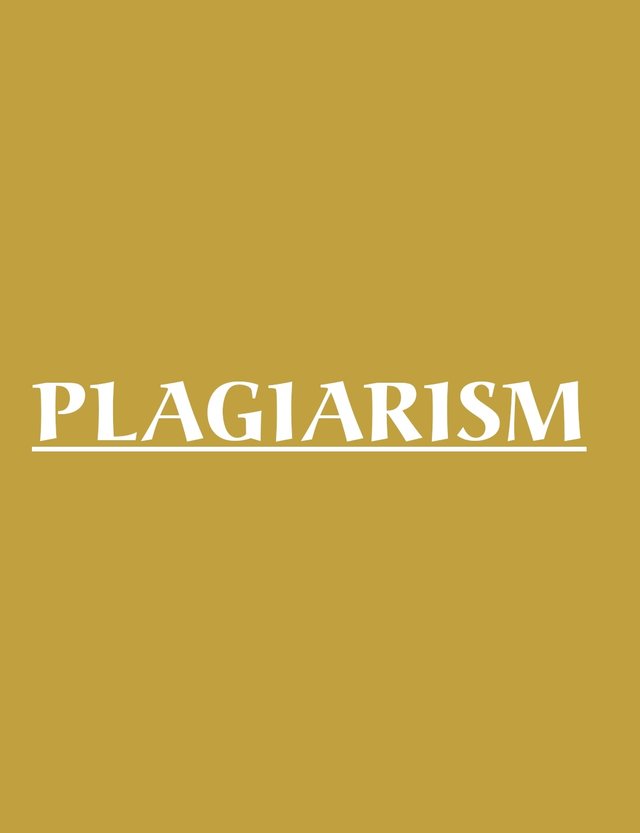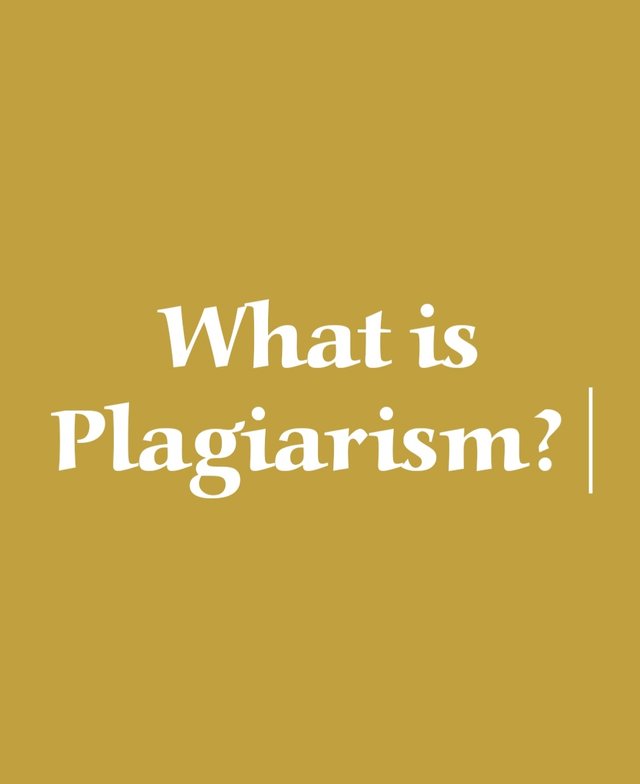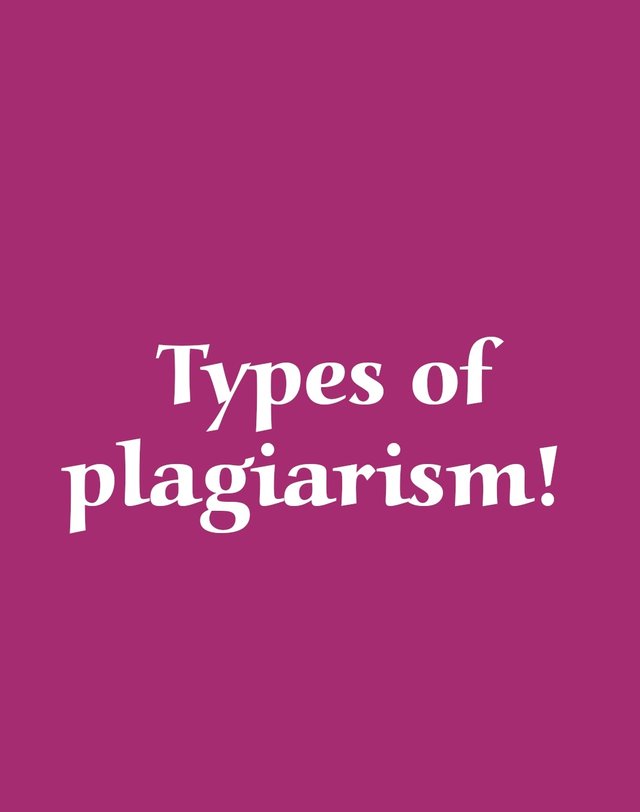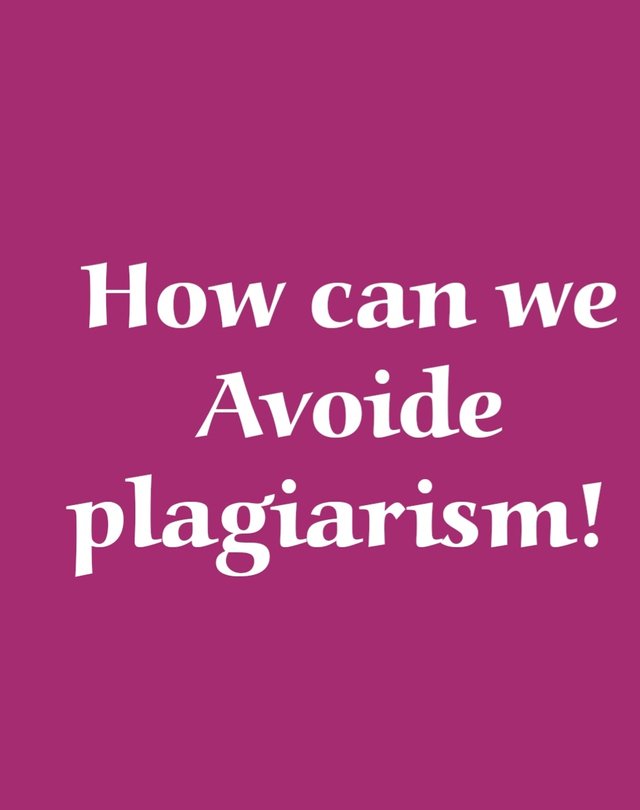Achievement3 by @maanirai Title:Content Etiquette

ASSALAM-O-ALAIKUM!
Greetings to everyone here on Steemit's platform!
By Allah please my #achievement2 has been completed for which thank you very much everyone and today I have come for a new task is #achievement3 whose title is Plagiarism. So let's start the conversation we want.

WHAT IS PLAGIARISM?
Ans:*
Plagiarism is essentially theft and fraud committed simultaneously. It is considered theft because the writer takes ideas from a source without giving proper credit to the author. ... Plagiarism can be illegal, and a violation of Unites States copyright laws.
All of the following are considered plagiarism:,
1:,
Turning in someone else's work as your own
2:,
Copying words or ideas from someone else without giving credit
3:,
Failing to put a quotation in quotation marks
4:,
Giving incorrect information about the source of a quotation
5:,
Changing words but copying the sentence structure of a source without giving credit
6:,
Copying so many words or ideas from a source that it makes up the majority of your work, whether you give credit or not.
7*:,
Most cases of plagiarism can be avoided, however, by citing sources. Simply acknowledging that certain material has been borrowed and providing your audience with the information necessary to find that source is usually enough to prevent plagiarism.

GUYS MANY TYPES OF PLAGIARISM LIKE:,
1:,
MOSAIC OR PATCHWORK PLAGIARISM;
With this type of plagiarism, the work of someone else is simply paraphrased without proper citation. It’s often difficult to detect because the plagiarized material is interwoven with many different sources, including the writer’s own ideas and perspective.
This type of paraphrasing can be done from one or several sources. The writer may try to change up the sentence structure or use synonyms to make it seem original. However, taking the idea of another piece is still plagiarism, even if the words are switched up a bit and intermingled with original thought.
2:,
PARAPHRASING PLAGIARISM;
Paraphrasing, or incremental plagiarism, is the most common type of plagiarism. It’s similar to the mosaic plagiarism style mentioned above. However, the difference is that the copied work isn’t mixed in with new concepts and research. When you paraphrase the original idea in your own words, the borrowed material stays the same throughout the new piece.
3:,
COMPLETE PLAGIARISM;
Complete plagiarism is more common in academic writing than in content marketing or other types of online writing. This type of plagiarism occurs when someone tries to submit an entire research paper as their own without proper attribution.
For example
This involves copying and pasting the original work in its exact words. The only thing that is changed is the author’s name.
4:,
SELF-PLAGIARISM;
Also known as auto-plagiarism, self-plagiarism happens when you copy your own writing, whether intentional or not. Often the person in a self-plagiarism incident is summarizing or repurposing their own work instead of writing a whole new piece from scratch on the same topic.
Many people think self-plagiarism is harmless because you aren’t stealing from someone else. Just yourself. But, this type of plagiarism can be just as damaging as any other.
For example
If you are writing web pages and you are caught plagiarizing, you could end up getting penalized by Google for duplicate content.
Or, if you are writing for clients, your words may no longer belong to you. This could even result in potential legal issues if it is a breach of your client contract.
5:,
ACCIDENTAL PLAGIARISM;
Plagiarism doesn’t always happen on purpose. It’s still considered plagiarism when someone copies another’s writing without citing their source, improperly cites the source or leaves out quotation marks on accident. Just because the omission or incorrect citation was accidental doesn’t mean plagiarism hasn’t been committed. This is why it’s important to check any work and when in doubt, give your source credit.
6:,
SOURCE-BASED PLAGIARISM;
This type of plagiarism refers to instances when misleading sources are involved. For example, the writer may have two sources of information but only reference one. Another form of source-based plagiarism would be when an author quotes a non-existent or incorrect source.
The worst type of this kind of plagiarism is when sources are fabricated. Making up information like study findings or statistics is extremely misleading and can even be harmful in the case of medical content.
7:,
DIRECT OR VERBATIM PLAGIARISM;
Direct plagiarism, also known as verbatim or copy-paste plagiarism, is an intentional and unethical form of stealing content. As the name suggests, the writing is stolen word for word and pasted into the new piece. The author then tries to pass off the content as their own. A word or two might be changed, but this type of plagiarism is too blatant to be considered paraphrasing.

SOME WAYS TO AVOID FROM PLAGIARISM:
1:,
Choose a topic you want to learn more about;
You’re in English Lit class and your teacher makes the announcement that causes every student to groan: There will be a research paper. Choose an author and write a paper about [fill in the blank].
This is English Lit. There must be one author in the entire canon of English Literature that you’d be interested in learning something about.
All it takes is a little curiosity and some ambitious googling to find a topic you’re interested in. This applies to any research paper you are required to write for any class in your entire career as a student. If you’re really stumped, talk to your teacher. Maybe they can get you started in the right direction.
Why is choosing a topic you’re interested in the first step in avoiding plagiarism?
Because if you are already interested in learning about something, you are more likely to dig into the research.
If you are interested in Sylvia Plath’s intense, gory imagery in her poems, explore that! What was that all about? What motivated her? Did other poets do that, too?
Writing a research paper is already hard enough. At least make it interesting for yourself.
2:,
Slow and steady wins the race: Don’t procrastinate;
When did your English Lit teacher announce the research paper? In the second week of the term. Why? Because they know that this paper will take a long time to complete.
Do yourself a favor and start working on it right away, little by little.
Just like you can’t cram to learn basketball, rushing to write a term paper in three days is going to produce enormous amounts of stress and sleep deprivation. And that is when plagiarizing is most likely to happen: When you have a deadline looming and you just want to turn something in because you need to sleep.
Try to get a little done every day.
3:,
Be meticulous about your research notes;
However you keep track of your research – on paper or on a computer– make sure you have a system for taking research notes. The organization of your research notes will keep you from committing accidental plagiarism.
What, exactly, are research notes?
They are a way to organize your research: to remember what you’ve read, to keep track of any quotes you want to include, to paraphrase or summarize important information.
You will need to include a list of sources at the end of your paper. You can use your research notes for that.
If you want to include any quotes, go ahead and write them in your notes, and put the source next to them. Just make sure you show they are direct quotes so that when you write them in your paper, you write them exactly the same.
You might indicate a direct quote with quotation marks, so you can just copy and paste directly into your document (don’t forget to cite!). Or maybe you use bold, or blue font, or you highlight. Whatever makes sense to you, do that and be consistent.
If you want to paraphrase or summarize, you can already practice in your research notes, and put the source next to it. Again, make sure you know it’s a paraphrase or a summary, so you remember to cite the source when you write your paper.
4:,
Keep quotes as they are
When including direct quotes in your project;
Make sure to keep them as they appear in the source. Do not change any of the words. It’s okay to remove some words, but show the reader that words were removed by including an ellipsis (…) in their place.
Make sure to add quotation marks around the quote and include an in-text citation immediately following it. Don’t forget to add the full citation at the end of the project.
Although it is appropriate to use direct quotes in your paper (as long as they’re cited correctly) don’t rely too much on quotations. This is especially true for block quotes, which are longer blocks of text.
Remember that academic writing is about your ideas, your thinking, your learning. Of course you will use external sources to support your ideas, but the sources are the support. The main part of the writing should be your ideas.
If you have too many quotes, your ideas get buried, and the reader might start to wonder if you have anything original to say, or if you’re just repeating what someone else already said.
5:,
Paraphrase;
If you find information you’d like to include in your project, consider paraphrasing. Paraphrasing is the act of restating information in your own words. It often involves explaining, clarifying, or adding to the information.
Paraphrasing is appropriate in academic writing, and it is preferable to direct quotes. Why? Because you are already doing some of the work of interpreting the original source, processing the information, and finding a new way to state the ideas. Plus, since you are writing it, you retain your “voice.” If you use too many quotes, then your paper presents mostly other people’s voices, and yours gets lost.
To paraphrase, you want to keep the same idea while changing the way it is said as much as possible. If you don’t make many changes, a plagiarism checker might flag your paraphrase.
You can change the way something is said by:
using synonyms
changing the order of the words
making a statement into a question
changing the arrangement of clauses
changing positive to negative (or vice versa)
changing active voice to passive voice (or vice versa)
changing word forms
Paraphrasing well is a challenging skill, and like any skill, you will get better with practice.
6:,
Add citations in your project any time you use information from another source
Citing your sources is the main way to avoid plagiarism;
In fact, citing is what separates a correctly written paper from an academically dishonest one. It’s that important.
Citing sources means indicating when something written wasn’t your idea. Cite both direct quotes and paraphrases.
To correctly cite your sources, you will cite your sources in the text, using in-text citations. You will include more complete citations at the end of the paper, in a Works Cited page, reference list, or bibliography (more on that later). How you cite will depend on the style guide your teacher wants you to follow.
AT THE END;
THANK YOU SO MUCH*
@aliraza @cryptokannon @newbie
I hope I've answered all questions.I
Here ends my achievement post no.3
Hi, @maanirai,
Your post has been supported by the the Steem Greeter Team.
Be guided about the purpose of this Achievement task. Plagiarism and Content Etiquette plays a significant role in our Steemit journey as it will define us, writers. Plagiarism is also prohibited by law, so don't forget to give proper credit and citation if the words and pictures used are not yours. For the latest updates and important announcements, don't forget to follow @steemitblog and visit the Steemit Crypto Academy for you to learn about cryptocurrency.
You have been verified for this task and you may now advance to Achievement 4: Applying Markdown at your comfort. Please refer to the guide on the Newcomers Achievement Program on the Notice Board pinned post.
Curators Rate-2